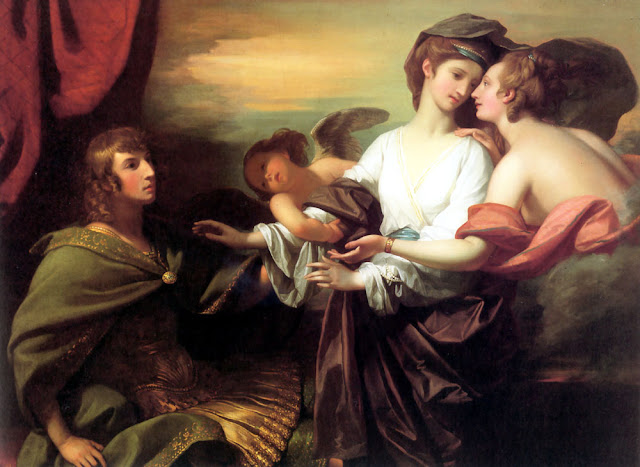West,Benjamin (1738-1820
West was born in Springfield, Pennsylvania, in a house that is now in the borough of Swarthmore on the campus of Swarthmore College,[1] as the tenth child of an innkeeper. The family later moved to Newtown Square, Pennsylvania, where his father was the proprietor of the Square Tavern, still standing in that town. West told John Galt, with whom, late in his life, he collaborated on a memoir, The Life and Studies of Benjamin West (1816, 1820) that, when he was a child, Native Americans showed him how to make paint by mixing some clay from the river bank with bear grease in a pot. Benjamin West was an autodidact; while excelling at the arts, "he had little [formal] education and, even when president of the Royal Academy, could scarcely spell".[2]
Benjamin West's Erasistratus the Physician Discovers the Love of Antiochus for Stratonice held at the Birmingham Museum of Art
From 1746 to 1759, West worked in Pennsylvania, mostly painting portraits. While in Lancaster, Pennsylvania, in 1756, West's patron, a gunsmith named William Henry, encouraged him to design a "Death of Socrates" based on an engraving in Charles Rollin's Ancient History; the resulting composition, which significantly differs from West's source, has been called "the most ambitious and interesting painting produced in colonial America".[3] Dr William Smith, then the provost of the College of Philadelphia, saw the painting in Henry's house and decided to patronize West, offering him education and, more importantly, connections with wealthy and politically connected Pennsylvanians. During this time West met John Wollaston, a famous painter who immigrated from London. West learned Wollaston's techniques for painting the shimmer of silk and satin, and also adopted some of "his mannerisms, the most prominent of which was to give all his subjects large almond-shaped eyes, which clients thought very chic".[4]
.jpg)
.1.jpg)














Tidak ada komentar:
Posting Komentar